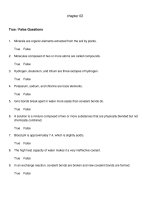Vanders human physiology the mechanisms of body function 13th edition widmaier test bank
Bạn đang xem bản rút gọn của tài liệu. Xem và tải ngay bản đầy đủ của tài liệu tại đây (554.91 KB, 33 trang )
Chapter 02 Test Bank
Student: ___________________________________________________________________________
1. Which correctly describes the structure of an atom?
A. There are always the same number of protons and neutrons.
B. There are always the same number of protons and electrons.
C. There are always the same number of neutrons and electrons.
D. The number of protons, neutrons, and electrons is always the same
E. There are never the same number of neutrons and protons.
2.
A.
B.
C.
D.
E.
What directly determines an atom's identity?
the number of electrons
the number of neutrons
the number of protons
the number of bonds it can form
the ratio of protons to electrons
3.
A.
B.
C.
D.
E.
Carbon-12 and carbon-14 are isotopes. How are they different from each other?
different numbers of protons
different numbers of neutrons
different numbers of electrons
they can form different numbers of chemical bonds
different number of energy shells
4.
A.
B.
C.
D.
E.
Which is a covalent bond?
two atoms share inner-orbit electrons with each other
a bond between water molecules
a bond between two oppositely charged ions
a bond between two free radicals
two atoms share outer orbit electrons with each other
5.
A.
B.
C.
D.
E.
Ions are
electrically neutral.
electrically charged.
formed by the gain or loss of protons from the nucleus.
insoluble in water.
nonpolar atoms.
6.
A.
B.
C.
D.
E.
When magnesium loses electrons to become an ion, what does it become?
a covalent molecule
a cation
an anion
a new element
a free radical
7.
A.
B.
C.
D.
E.
If a sports beverage advertises that it replaces the body's electrolytes, what does the drink contain?
sugars that were broken down for energy
ionic forms of mineral elements
lipids that form the membranes of cells
oxygen and gases used by metabolism
vitamins
8.
A.
B.
C.
D.
E.
Of these major ions found in the body, which one carries a negative charge?
Chloride
Sodium
Potassium
Hydrogen
Calcium
9.
A.
B.
C.
D.
E.
Which describes a characteristic of free radicals?
They rapidly oxidize other atoms by removing an electron.
They are inert molecules that don't interact readily with other molecules.
They contain two electrons in the outermost orbital.
They have extra neutrons in their nuclei.
They are found in high quantities in most sports drinks.
10. Which is true about electrolytes?
A. They are neutral atoms.
B. They conduct electricity when dissolved in water.
C. They are found in pure water.
D. They have equal numbers of protons and electrons.
E. They are insoluble in water.
11.
A.
B.
C.
D.
Which of the following is not true of a polar chemical bond?
It is covalent
It is ionized
It has opposite electrical charge at each end
It has no net electrical charge
12. Which best describes a hydrolysis reaction?
A. Molecules are broken down into smaller ones by breaking covalent bonds within water molecules and
transferring hydrogen atoms and hydroxyl groups to the smaller ones.
B. Electrically-charged molecules separate into ions when they dissolve in water, and then hydrogen ions and
hydroxyl groups covalently attach themselves to the oppositely-charged ions.
C. Large molecules are assembled from smaller ones by breaking water into hydrogen and hydroxyl ions.
D. Dissolving a large molecule in water reduces it to its individual atoms.
E. The breaking of hydrogen bonds between any two molecules.
13.
Oil spilled into the ocean does not easily disperse, but rather clumps into an oil slick. Which of the following explains why this occurs?
A. Oil is composed mainly of hydrophilic molecules.
B. Oil is composed mainly of nonpolar molecules.
C. Oil has no hydrogen in its molecular structure, so it can't form hydrogen bonds with water.
D. Water is hydrophobic.
E. Electrons are shared unequally between carbon and hydrogen atoms.
14. Molecules that have properties of both polar and nonpolar molecules are called
A. hydrophobic
B. hydrophilic
C. amphipathic
D. unipolar
E. bipolar
15. Compounds A, B and C have molecular weights of 10, 50 and 100 respectively. If 5 grams of each
compound were put into 1 liter of water, which compound will have the greatest molar concentration?
A. Compound A
B. Compound B
C. Compound C
D. All will have the same molar concentration
16. The pH of a solution
A. is a measure of the concentration of hydrogen atoms in the solution.
B. is a measure of the concentration of hydrogen ions bound to other molecules in the solution.
C. is a measure of the concentration of free hydrogen ions in the solution.
D. increases as the acidity of the solution increases.
E. increases as the free hydrogen ion concentration in the solution increases.
17. Most of the body weight of an average young adult male is what substance?
A. Water
B. Protein
C. Minerals
D. Lipids
E. Carbohydrates
18. Which is true about the composition of organic molecules?
A. They always contain oxygen.
B. They always contain carbon.
C. They are always macromolecules.
D. They never contain hydrogen.
E. They never contain oxygen.
19. Carbohydrates:
A. have carbon and oxygen atoms in equal proportions.
B. are the major organic molecules of the body by mass.
C. are nonpolar molecules.
D. are defined by the inclusion of nitrogen in their structure.
E. are composed of only carbon and hydrogen atoms.
20. Which chemical group does glucose best fit into?
A. monosaccharides
B. disaccharides
C. polysaccharides
D. glycoproteins
E. phospholipids
21. Carbohydrates are stored in the liver and muscles in the form of
A. cellulose.
B. starch.
C. triacylglycerol.
D. glycogen.
E. protein.
22. What are the two main atoms in lipids, and what type of bonds connect them?
A. carbon and oxygen, connected by covalent bonds.
B. carbon and hydrogen, connected by covalent bonds
C. carbon and hydrogen, connected by ionic bonds
D. carbon and hydrogen, connected by hydrogen bonds
E. oxygen and hydrogen, connected by hydrogen bonds
23. Eicosanoids are an important class of regulatory molecules; what chemical class do they belong to?
A. steroids
B. proteins
C. carbohydrates
D. fatty acids
E. amino acids
24. Which statement is FALSE with regard to proteins?
A. Their roles in the body include acting as enzymes, providing structural support, and signaling between
cells.
B. They make up a greater percentage of body mass than carbohydrates do.
C. They are composed of nucleic acids.
D. They are macromolecules with subunits linked by polypeptide bonds.
E. They are polymers made up of amino acids.
25. What best describes the main determinant of the secondary structure of a protein?
A. the sequence of the various amino acids that make up a polypeptide chain
B. the total number of amino acids that make up a polypeptide chain, and its overall resulting length
C. the total number of polypeptide chains that combine to determine the overall size of the protein
D. molecular interactions between widely separated regions of a polypeptide, such as disulfide bonds, that
stabilize the folded conformation
E. molecular interactions along a polypeptide chain that fold various regions into alpha helices or beta sheets
26. Which of the following is NOT a type of molecular interaction that determines the tertiary structure of a
protein?
A. covalent bonds between purines and pyrimidine bases
B. ionic bonds
C. Van der Waals forces
D. covalent bonds between two cysteine amino acids
E. hydrogen bonds
27. What is the term describing the covalent bond formed between two amino acids?
A. Glycosidic bond
B. Peptide bond
C. Phosphodiester bond
D. Ester bond
E. Hydrolytic bond
28. Which is a correct description of nucleic acids?
A. They are polymers of subunits containing glucose an an amino acids.
B. They are polymers of subunits containing glucose, a phosphate group, and an amino acid.
C. They are polymers of subunits containing a phosphate group, a sugar, and a purine or pyrimidine base.
D. They are pollymers of subunits containing a phosphate group, a sugar, and an amino acid.
E. They are long polymers of amino acids, folded into an alpha helix.
29. Which best describes the main role of adenosine triphosphate (ATP)?
A. It is an amino acid that is part of polypeptide chains that serve structural functions within cells.
B. It is a nucleotide that makes up the backbone of DNA and RNA molecules, that harbor the genetic code.
C. It is a carbohydrate molecule that can be stored in large quantities in the liver to energize cellular processes.
D. It is a purine derivative created from the breakdown of fuel molecules, that transfers energy for cellular
processes.
E. It is a waste product of aerobic metabolism that is excreted from the body by the kidneys.
30. An atom is electrically neutral.
True False
31. The mass of an atom is the sum of its protons and electrons.
True False
32. The atomic number of an element is given by the number of electrons in the atom.
True False
33. An atomic nucleus is electrically neutral.
True False
34. Protons and neutrons have roughly the same mass.
True False
35. The atomic number of an element refers to the number of particles in its atomic nucleus.
True False
36. Twelve grams of C contains the same number of atoms as one gram of H.
True False
37. The four most common elements in the body are hydrogen, carbon, calcium and oxygen.
True False
38. Important mineral elements in the body include Na, Ca and K.
True False
39. Trace elements such as zinc and manganese are found in minute quantities in the body but do not serve any
known function.
True False
40. The number of covalent bonds that can be formed by a given atom depends upon the number of electrons
present in the outermost orbit.
True False
41. Nitrogen atoms can form a maximum of four covalent bonds with other atoms.
True False
42. The shape of a molecule may change as atoms rotate about their covalent bonds.
True False
43. All of the physiologically important atoms of the body readily form ions.
True False
44. Water molecules can form covalent bonds with other water molecules.
True False
45. In a molecule of water, an oxygen atom forms a double bond with each of two hydrogen atoms.
True False
46. The carboxyl ion is an anion.
True False
47. NaCl is a molecule formed by the covalent bonding of a sodium atom to a chlorine atom.
True False
48. All covalent bonds are polar.
True False
49. During hydrolysis, hydrogen ions and hydroxyl groups are formed.
True False
50. In general, polar molecules will dissolve in polar solvents, while nonpolar molecules cannot.
True False
51. Solutes that do not dissolve in water are called hydrophilic.
True False
52. Molecules with both polar and nonpolar regions are called ambidextrous.
True False
53. The molarity of a solution is a measure of the concentration of the solute.
True False
54. A solution with a pH of 8 is more acidic than one with a pH of 3.
True False
55. Organic chemistry is the study of oxygen-containing compounds.
True False
56. When multiple repeating simple sugar molecules combine to form a larger molecule, it is called a
polysaccharide.
True False
57. Sucrose is called "blood sugar" because it is the most abundant carbohydrate in the blood.
True False
58. Triacylglycerol is one subclass of lipid molecules.
True False
59. Saturated fats contain carbon atoms linked by double bonds.
True False
60. Cholesterol is a phospholipid.
True False
61. Glycoproteins are protein molecules with molecules of glycogen attached to the amino acid side chains.
True False
62. The sequence of amino acids in a protein is known as the secondary structure.
True False
63. A protein may consist of more than one polypeptide chain.
True False
64. Substitution of one amino acid for a different one in a given protein always significantly alters the
conformation of that protein.
True False
65. In DNA, thymine binds with adenine and cytosine binds with uracil.
True False
66.
True False
67.
True False
Chapter 02 Test Bank Key
1. Which correctly describes the structure of an atom?
A. There are always the same number of protons and neutrons.
B. There are always the same number of protons and electrons.
C. There are always the same number of neutrons and electrons.
D. The number of protons, neutrons, and electrons is always the same
E. There are never the same number of neutrons and protons.
Bloom's: Level 1. Remember
Learning Outcome: 02.01
Section: 02.01
Topic: Chemistry
Topic: Nutrition and Metabolism
Topic: Plants
Topic: Reproductive System
Topic: Respiratory System
Topic: Skeletal System
Topic: Urinary System
Topic: Water, Electrolyte, and Acid-Base Balance
2.
A.
B.
C.
D.
E.
What directly determines an atom's identity?
the number of electrons
the number of neutrons
the number of protons
the number of bonds it can form
the ratio of protons to electrons
Bloom's: Level 1. Remember
Learning Outcome: 02.01
Section: 02.01
Topic: Chemistry
3.
A.
B.
C.
D.
E.
Carbon-12 and carbon-14 are isotopes. How are they different from each other?
different numbers of protons
different numbers of neutrons
different numbers of electrons
they can form different numbers of chemical bonds
different number of energy shells
Bloom's: Level 1. Remember
Learning Outcome: 02.01
Section: 02.01
Topic: Chemistry
4.
A.
B.
C.
D.
E.
Which is a covalent bond?
two atoms share inner-orbit electrons with each other
a bond between water molecules
a bond between two oppositely charged ions
a bond between two free radicals
two atoms share outer orbit electrons with each other
Bloom's: Level 1. Remember
Learning Outcome: 02.02
Section: 02.02
Topic: Chemistry
5.
A.
B.
C.
D.
E.
Ions are
electrically neutral.
electrically charged.
formed by the gain or loss of protons from the nucleus.
insoluble in water.
nonpolar atoms.
Bloom's: Level 1. Remember
Learning Outcome: 02.01
Section: 02.01
Topic: Chemistry
6.
A.
B.
C.
D.
E.
When magnesium loses electrons to become an ion, what does it become?
a covalent molecule
a cation
an anion
a new element
a free radical
Bloom's: Level 2. Understand
Learning Outcome: 02.01
Section: 02.01
Topic: Chemistry
7.
A.
B.
C.
D.
E.
If a sports beverage advertises that it replaces the body's electrolytes, what does the drink contain?
sugars that were broken down for energy
ionic forms of mineral elements
lipids that form the membranes of cells
oxygen and gases used by metabolism
vitamins
Bloom's: Level 1. Remember
Learning Outcome: 02.01
Section: 02.01
Topic: Chemistry
8.
A.
B.
C.
D.
E.
Of these major ions found in the body, which one carries a negative charge?
Chloride
Sodium
Potassium
Hydrogen
Calcium
Bloom's: Level 1. Remember
Learning Outcome: 02.01
Section: 02.01
Topic: Chemistry
9.
A.
B.
C.
D.
E.
Which describes a characteristic of free radicals?
They rapidly oxidize other atoms by removing an electron.
They are inert molecules that don't interact readily with other molecules.
They contain two electrons in the outermost orbital.
They have extra neutrons in their nuclei.
They are found in high quantities in most sports drinks.
Bloom's: Level 1. Remember
Learning Outcome: 02.02
Section: 02.02
Topic: Chemistry
10. Which is true about electrolytes?
A. They are neutral atoms.
B. They conduct electricity when dissolved in water.
C. They are found in pure water.
D. They have equal numbers of protons and electrons.
E. They are insoluble in water.
Bloom's: Level 1. Remember
Learning Outcome: 02.01
Section: 02.01
Topic: Chemistry
11.
A.
B.
C.
D.
Which of the following is not true of a polar chemical bond?
It is covalent
It is ionized
It has opposite electrical charge at each end
It has no net electrical charge
Bloom's: Level 2. Understand
Learning Outcome: 02.02
Section: 02.02
Topic: Chemistry
12. Which best describes a hydrolysis reaction?
A. Molecules are broken down into smaller ones by breaking covalent bonds within water molecules and
transferring hydrogen atoms and hydroxyl groups to the smaller ones.
B. Electrically-charged molecules separate into ions when they dissolve in water, and then hydrogen ions and
hydroxyl groups covalently attach themselves to the oppositely-charged ions.
C. Large molecules are assembled from smaller ones by breaking water into hydrogen and hydroxyl ions.
D. Dissolving a large molecule in water reduces it to its individual atoms.
E. The breaking of hydrogen bonds between any two molecules.
Bloom's: Level 2. Understand
Learning Outcome: 02.03
Section: 02.03
Topic: Chemistry
13.
Oil spilled into the ocean does not easily disperse, but rather clumps into an oil slick. Which of the following explains why this occurs?
A. Oil is composed mainly of hydrophilic molecules.
B. Oil is composed mainly of nonpolar molecules.
C. Oil has no hydrogen in its molecular structure, so it can't form hydrogen bonds with water.
D. Water is hydrophobic.
E. Electrons are shared unequally between carbon and hydrogen atoms.
Bloom's: Level 2. Understand
Learning Outcome: 02.02
Section: 02.02
Topic: Chemistry
14. Molecules that have properties of both polar and nonpolar molecules are called
A. hydrophobic
B. hydrophilic
C. amphipathic
D. unipolar
E. bipolar
Bloom's: Level 1. Remember
Learning Outcome: 02.03
Section: 02.03
Topic: Chemistry
15. Compounds A, B and C have molecular weights of 10, 50 and 100 respectively. If 5 grams of each
compound were put into 1 liter of water, which compound will have the greatest molar concentration?
A. Compound A
B. Compound B
C. Compound C
D. All will have the same molar concentration
Bloom's: Level 2. Understand
Learning Outcome: 02.03
Section: 02.03
Topic: Chemistry
16. The pH of a solution
A. is a measure of the concentration of hydrogen atoms in the solution.
B. is a measure of the concentration of hydrogen ions bound to other molecules in the solution.
C. is a measure of the concentration of free hydrogen ions in the solution.
D. increases as the acidity of the solution increases.
E. increases as the free hydrogen ion concentration in the solution increases.
Bloom's: Level 1. Remember
Learning Outcome: 02.03
Section: 02.03
Topic: Chemistry
17. Most of the body weight of an average young adult male is what substance?
A. Water
B. Protein
C. Minerals
D. Lipids
E. Carbohydrates
Bloom's: Level 1. Remember
Learning Outcome: 02.03
Section: 02.03
Topic: Chemistry
18. Which is true about the composition of organic molecules?
A. They always contain oxygen.
B. They always contain carbon.
C. They are always macromolecules.
D. They never contain hydrogen.
E. They never contain oxygen.
Bloom's: Level 1. Remember
Learning Outcome: 02.04
Section: 02.04
Topic: Chemistry
19. Carbohydrates:
A. have carbon and oxygen atoms in equal proportions.
B. are the major organic molecules of the body by mass.
C. are nonpolar molecules.
D. are defined by the inclusion of nitrogen in their structure.
E. are composed of only carbon and hydrogen atoms.
Bloom's: Level 2. Understand
Learning Outcome: 02.04
Section: 02.04
Topic: Chemistry
20. Which chemical group does glucose best fit into?
A. monosaccharides
B. disaccharides
C. polysaccharides
D. glycoproteins
E. phospholipids
Bloom's: Level 1. Remember
Learning Outcome: 02.04
Section: 02.04
Topic: Chemistry
21. Carbohydrates are stored in the liver and muscles in the form of
A. cellulose.
B. starch.
C. triacylglycerol.
D. glycogen.
E. protein.
Bloom's: Level 1. Remember
Learning Outcome: 02.04
Section: 02.04
Topic: Chemistry
22. What are the two main atoms in lipids, and what type of bonds connect them?
A. carbon and oxygen, connected by covalent bonds.
B. carbon and hydrogen, connected by covalent bonds
C. carbon and hydrogen, connected by ionic bonds
D. carbon and hydrogen, connected by hydrogen bonds
E. oxygen and hydrogen, connected by hydrogen bonds
Bloom's: Level 1. Remember
Learning Outcome: 02.04
Section: 02.04
Topic: Chemistry
23. Eicosanoids are an important class of regulatory molecules; what chemical class do they belong to?
A. steroids
B. proteins
C. carbohydrates
D. fatty acids
E. amino acids
Bloom's: Level 1. Remember
Learning Outcome: 02.04
Section: 02.04
Topic: Chemistry
24. Which statement is FALSE with regard to proteins?
A. Their roles in the body include acting as enzymes, providing structural support, and signaling between
cells.
B. They make up a greater percentage of body mass than carbohydrates do.
C. They are composed of nucleic acids.
D. They are macromolecules with subunits linked by polypeptide bonds.
E. They are polymers made up of amino acids.
Bloom's: Level 1. Remember
Learning Outcome: 02.04
Section: 02.04
Topic: Chemistry
25. What best describes the main determinant of the secondary structure of a protein?
A. the sequence of the various amino acids that make up a polypeptide chain
B. the total number of amino acids that make up a polypeptide chain, and its overall resulting length
C. the total number of polypeptide chains that combine to determine the overall size of the protein
D. molecular interactions between widely separated regions of a polypeptide, such as disulfide bonds, that
stabilize the folded conformation
E. molecular interactions along a polypeptide chain that fold various regions into alpha helices or beta sheets
Bloom's: Level 1. Remember
Learning Outcome: 02.04
Section: 02.04
Topic: Chemistry
26. Which of the following is NOT a type of molecular interaction that determines the tertiary structure of a
protein?
A. covalent bonds between purines and pyrimidine bases
B. ionic bonds
C. Van der Waals forces
D. covalent bonds between two cysteine amino acids
E. hydrogen bonds
Bloom's: Level 2. Understand
Learning Outcome: 02.04
Section: 02.04
Topic: Chemistry
27. What is the term describing the covalent bond formed between two amino acids?
A. Glycosidic bond
B. Peptide bond
C. Phosphodiester bond
D. Ester bond
E. Hydrolytic bond
Bloom's: Level 1. Remember
Learning Outcome: 02.04
Section: 02.04
Topic: Chemistry
28. Which is a correct description of nucleic acids?
A. They are polymers of subunits containing glucose an an amino acids.
B. They are polymers of subunits containing glucose, a phosphate group, and an amino acid.
C. They are polymers of subunits containing a phosphate group, a sugar, and a purine or pyrimidine base.
D. They are pollymers of subunits containing a phosphate group, a sugar, and an amino acid.
E. They are long polymers of amino acids, folded into an alpha helix.
Bloom's: Level 1. Remember
Learning Outcome: 02.04
Section: 02.04
Topic: Chemistry
29. Which best describes the main role of adenosine triphosphate (ATP)?
A. It is an amino acid that is part of polypeptide chains that serve structural functions within cells.
B. It is a nucleotide that makes up the backbone of DNA and RNA molecules, that harbor the genetic code.
C. It is a carbohydrate molecule that can be stored in large quantities in the liver to energize cellular processes.
D. It is a purine derivative created from the breakdown of fuel molecules, that transfers energy for cellular
processes.
E. It is a waste product of aerobic metabolism that is excreted from the body by the kidneys.
Bloom's: Level 1. Remember
Learning Outcome: 02.04
Section: 02.04
Topic: Chemistry
30. An atom is electrically neutral.
TRUE
Bloom's: Level 1. Remember
Learning Outcome: 02.01
Section: 02.01
Topic: Chemistry
31. The mass of an atom is the sum of its protons and electrons.
FALSE
Bloom's: Level 1. Remember
Learning Outcome: 02.01
Section: 02.01
Topic: Chemistry
32. The atomic number of an element is given by the number of electrons in the atom.
FALSE
Bloom's: Level 1. Remember
Learning Outcome: 02.01
Section: 02.01
Topic: Chemistry
33. An atomic nucleus is electrically neutral.
FALSE
Bloom's: Level 1. Remember
Learning Outcome: 02.01
Section: 02.01
Topic: Chemistry
34. Protons and neutrons have roughly the same mass.
TRUE
Bloom's: Level 1. Remember
Learning Outcome: 02.01
Section: 02.01
Topic: Chemistry
35. The atomic number of an element refers to the number of particles in its atomic nucleus.
FALSE
Bloom's: Level 1. Remember
Learning Outcome: 02.01
Section: 02.01
Topic: Chemistry
36. Twelve grams of C contains the same number of atoms as one gram of H.
TRUE
Bloom's: Level 2. Understand
Learning Outcome: 02.01
Section: 02.01
Topic: Chemistry
37. The four most common elements in the body are hydrogen, carbon, calcium and oxygen.
FALSE
Bloom's: Level 1. Remember
Learning Outcome: 02.01
Section: 02.01
Topic: Chemistry
38. Important mineral elements in the body include Na, Ca and K.
TRUE
Bloom's: Level 1. Remember
Learning Outcome: 02.01
Section: 02.01
Topic: Chemistry
39. Trace elements such as zinc and manganese are found in minute quantities in the body but do not serve any
known function.
FALSE
Bloom's: Level 1. Remember
Learning Outcome: 02.01
Section: 02.01
Topic: Chemistry
40. The number of covalent bonds that can be formed by a given atom depends upon the number of electrons
present in the outermost orbit.
TRUE
Bloom's: Level 1. Remember
Learning Outcome: 02.01
Learning Outcome: 02.02
Section: 02.01
Section: 02.02
Topic: Chemistry
41. Nitrogen atoms can form a maximum of four covalent bonds with other atoms.
FALSE
Bloom's: Level 1. Remember
Learning Outcome: 02.01
Learning Outcome: 02.02
Section: 02.01
Section: 02.02
Topic: Chemistry
42. The shape of a molecule may change as atoms rotate about their covalent bonds.
TRUE
Bloom's: Level 1. Remember
Learning Outcome: 02.02
Section: 02.02
Topic: Chemistry
43. All of the physiologically important atoms of the body readily form ions.
FALSE
Bloom's: Level 2. Understand
Learning Outcome: 02.01
Section: 02.01
Topic: Chemistry
44. Water molecules can form covalent bonds with other water molecules.
FALSE
Bloom's: Level 1. Remember
Learning Outcome: 02.02
Section: 02.02
Topic: Chemistry
45. In a molecule of water, an oxygen atom forms a double bond with each of two hydrogen atoms.
FALSE
Bloom's: Level 1. Remember
Learning Outcome: 02.02
Section: 02.02
Topic: Chemistry
46. The carboxyl ion is an anion.
TRUE
Bloom's: Level 2. Understand
Learning Outcome: 02.01
Learning Outcome: 02.02
Section: 02.01
Section: 02.02
Topic: Chemistry
47. NaCl is a molecule formed by the covalent bonding of a sodium atom to a chlorine atom.
FALSE
Bloom's: Level 1. Remember
Learning Outcome: 02.02
Section: 02.02
Topic: Chemistry
48. All covalent bonds are polar.
FALSE
Bloom's: Level 1. Remember
Learning Outcome: 02.02
Section: 02.02
Topic: Chemistry
49. During hydrolysis, hydrogen ions and hydroxyl groups are formed.
TRUE
Bloom's: Level 1. Remember
Learning Outcome: 02.03
Section: 02.03
Topic: Chemistry
50. In general, polar molecules will dissolve in polar solvents, while nonpolar molecules cannot.
TRUE
Bloom's: Level 1. Remember
Learning Outcome: 02.03
Section: 02.03
Topic: Chemistry
51. Solutes that do not dissolve in water are called hydrophilic.
FALSE
Bloom's: Level 1. Remember
Learning Outcome: 02.03
Section: 02.03
Topic: Chemistry
52. Molecules with both polar and nonpolar regions are called ambidextrous.
FALSE
Bloom's: Level 1. Remember
Learning Outcome: 02.03
Section: 02.03
Topic: Chemistry
53. The molarity of a solution is a measure of the concentration of the solute.
TRUE
Bloom's: Level 1. Remember
Learning Outcome: 02.03
Section: 02.03
Topic: Chemistry
54. A solution with a pH of 8 is more acidic than one with a pH of 3.
FALSE
Bloom's: Level 1. Remember
Learning Outcome: 02.03
Section: 02.03
Topic: Chemistry
55. Organic chemistry is the study of oxygen-containing compounds.
FALSE
Bloom's: Level 1. Remember
Learning Outcome: 02.04
Section: 02.04
Topic: Chemistry
56. When multiple repeating simple sugar molecules combine to form a larger molecule, it is called a
polysaccharide.
TRUE
Bloom's: Level 1. Remember
Learning Outcome: 02.04
Section: 02.04
Topic: Chemistry
57. Sucrose is called "blood sugar" because it is the most abundant carbohydrate in the blood.
FALSE
Bloom's: Level 1. Remember
Learning Outcome: 02.04
Section: 02.04
Topic: Chemistry
58. Triacylglycerol is one subclass of lipid molecules.
TRUE
Bloom's: Level 1. Remember
Learning Outcome: 02.04
Section: 02.04
Topic: Chemistry
59. Saturated fats contain carbon atoms linked by double bonds.
FALSE
Bloom's: Level 1. Remember
Learning Outcome: 02.04
Section: 02.04
Topic: Chemistry
60. Cholesterol is a phospholipid.
FALSE
Bloom's: Level 1. Remember
Learning Outcome: 02.04
Section: 02.04
Topic: Chemistry
61. Glycoproteins are protein molecules with molecules of glycogen attached to the amino acid side chains.
FALSE
Bloom's: Level 1. Remember
Learning Outcome: 02.04
Section: 02.04
Topic: Chemistry
62. The sequence of amino acids in a protein is known as the secondary structure.
FALSE
Bloom's: Level 1. Remember
Learning Outcome: 02.04
Section: 02.04
Topic: Chemistry
63. A protein may consist of more than one polypeptide chain.
TRUE
Bloom's: Level 1. Remember
Learning Outcome: 02.04
Section: 02.04
Topic: Chemistry









